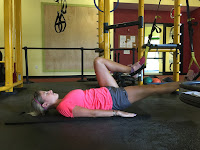One of the
most overlooked aspects of training is rest and recovery. Often
times complete rest for active people is very difficult. There are many
benefits to including active recovery sessions in your training. One of
the best places to perform an active recovery workout is in the water.
The water provides a non-weight bearing environment in that helps reduce stress
on the joints, provide traction to your spine, promote circulation and reduce
swelling to name a few. The shallow water can provide some of the same
benefits by reducing the amount of impact performing similar activities to
running. At waist level in the water you are about 50% weight bearing.
Last but not least, exercise in the water is fun!
Try these
aquatic recovery exercises to improve your performance, reduce your risk of
injury and add some variety to your training program.
Deep End Exercises
Wear a buoyancy belt. Perform waking exercises
for 2-3 laps & hanging exercises 10-15 repetitions.
Forward
Walking
Equipment: none
Action: Step forward in a normal walking pattern.
Alternate arms with each step while focusing on forward movement with proper
alignment and posture.
Walk +
Stretch
Equipment: none
Action: Walk 3 steps then kick your leg forward, reaching for your
foot with the opposite arm. Walk 3 steps
and repeat with the other arm and leg.
Keep torso straight and keep toes up.
Symmetrical
Walking with Turns
Equipment: none
Action: While walking forward turn palms out and push
arms out to align with shoulders. Arms make a breast stroke motion. Bring arms
to chest. Return to start position. Take 3 strokes forward, then turn 180 degrees
and walk 3 strokes backwards, turn 180 degrees and repeat.
Splits +
Spreads
Equipment: 2 long bars
Action: Separate legs in open scissors kick position:
one leg straight forward, another leg straight back. Return to start position. Repeat with the
other leg forward. Return to start
position. Spread both legs apart to the
sides, keeping toes up and legs straight.
Return to start position.
Tips: Keep legs straight and attain full range of
motion with each movement. Feel the
stretch while keeping toes up to.
Leg Stretch
Series
Equipment: 2 long bars
Action: Bend one knee to a 90° position, keeping toes up. Extend leg
straight in front of the body then back to the 90° position. Return to start
position. Repeat with the other leg. Repeat the sequence changing leg extension
of the knee to an internal position (kicking across the body) then an external
position (kicking out).
Running
Pendulum
Equipment: 2 long bars
Action:
Run moving to the side lying position using four running steps;
pause. Return to start position. Repeat
moving to other side.
Shallow End Exercises
Perform
walking exercises for 2-3 laps & stationary exercises 10-15 repetitions.
Weight Shift Catch
Action:
Shift weight to one leg and simultaneously catch and lift the knee with
both arms and pull the knee to the chest, hold the balance. Return to start
position. Repeat with the other leg.
Tips:
Maintain straight body alignment while pulling the knee up. Come up on
the toes each time when pulling the knee up.
Catch + Pull
Action: Walk forward 3 steps and catch one foot with the opposite arm
behind body, the other arm reaches straight above the head. Return to starting position. Walk forward 3 steps and repeat with the
opposite hand and foot. For an added
challenge—before you catch the foot, bend the weight bearing knee down into a
squat position and power up to your toes.
Leg Swing
Action: Walk forward 3 steps, stand on one leg while swinging the
other leg forward, back, forward. Swing the arms so opposite hand and foot are
in front. Was forward 3 steps and repeat
with the opposite side. Make sure to keep your body straight and sing the leg
high back and forth.
Squat Hurdles
Action: Walk forward 3 steps then squat, arms straight forward at
shoulder level. As you stand, mimic hurdle motion: one leg kicks straight out,
touching the foot with your opposite hand. Other arm extends back. Walk forward 3 steps and repeat with the
opposite hand and foot. Get the motion
in rhythm, kicking knee is straight, weight bearing leg is on the ball of the
foot.
Carioca
Action: Stand with arms out to side at shoulder level. Step side to
side crossing one foot in front then in back (like the grapevine). Take wide
steps, keeping your pelvis stable.
Blog post by Eric Chandler.
About Eric Chandler
Eric joins the Cape Cod Rehab Running
Team with a background in Exercise Science. He is a Certified Strength &
Conditioning Specialist (CSCS), certified in Part I & Part II of the
Burdenko Method, a Certified Functional Movement Screen (FMS) Specialist, and
has also been training in the TRX Suspension Training Method. Eric looks for his
clients’ strengths and uses those strengths to help them get the most out of
each session. A recreational runner, Eric has served on many of the CCR Flyers
Cape Cod Marathon relay teams as has a goal of breaking 20 minutes in the 5k.

























